| The Jaffa Gate Section |

|
Historic Overview:
In the Second Temple period,(the first century BCE) Herod rehabilitated the city walls and its gates and expanded the city toward the north. During this period the city had three walls. The exact route of the Third Wall, the most inclusive of the walls, remains a disputed topic among scholars. Some researchers believe that the route of the wall passed close to the present day route of the Jaffa Gate section. That is to say, it ran from Jaffa Gate to the northwestern corner of the Ottoman city wall and from there it continued toward the Russian Compound (erected in 1860).
In the Roman Period, for the first time, the route the city wall resembled that of the Late Ottoman wall.
In the Byzantine Period the wall continued to follow the Roman route and the fortifications were also reinforced. Remains of a bathhouse dating to this period were uncovered beneath the city wall, adjacent to Jaffa Gate. In addition, remains of a Byzantine street were discovered that extended from Jaffa Gate to the southwest.
In the Crusader Period the city walls, their gates, towers and citadels were rebuilt. The route of the city's western wall followed the future course of the Ottoman wall. Fortresses were built in the four corners of the city which could accommodate a large number of soldiers and their equipment.
In the Ayyubid Period Period the city was fortified and the walls were reinforced.
In archaeological excavations that were conducted in the early 1990's prior to the construction of the new Mamilla Compound, a segment of this wall was revealed at the foot of the Ottoman wall. This wall, built of large fieldstones, was preserved for a distance of c. 80 meters and an average height of 4.5 meters. In its southern part the base of the Ayyubid wall is built on top of the bathhouse walls dating to the Byzantine period, which were also exposed in archaeological excavations. Running the length of the wall it is apparent that Crusader building stones were put to secondary use as evidenced by the mason's marks and diagonal stone dressing of the stone surfaces. Alongside the wall is a destruction layer spread over an extensive area and indicative of deliberate damage. This layer is ascribed to the Ayyubid ruler, Mu'atim 'Isa, who built the wall and also demolished it so as to prevent a Crusader incursion into the city.
In the Ottoman Period Sultan Suleiman rebuilt the city walls. The route of the earlier walls from the Crusader and Fatimid period served as a foundation for this wall.
In the Jordanian Period new walls were constructed that were incorporated in the façade of the city wall and formed defensive positions in a number of the towers of the Ottoman city wall. These walls were connected to the city wall by bonded construction, whereby the stones of the city wall were dismantled and the new walls were attached to the stone courses of the tower. After 1967 the Jordanian walls were taken apart except for those in the tower near the Jaffa Gate.
During the British Mandatethe city walls were rehabilitated and the city wall promenade was built. A hand hold was installed along the wall's crenellations in the Jaffa Gate segment.
Jaffa Gate
Jaffa Gate, which is also known as the Bethlehem Gate, Hebron Gate and the Pilgrim's Gate, was constructed in 1538 CE. This is the main gate in the city's western wall. It is located at the end of two major roads. One leads south in the direction of Bethlehem and Hebron, and the other, being the more important of the two roads, leads west to Jaffa and the coastal cities. Jaffa Gate has been the subject of detailed descriptions in the writings of numerous sojourners and pilgrims thanks to its location, its size and its impressive features.
In the early nineteenth century the city's gates fulfilled their original function, which was that of defense. They were opened at dawn and closed at dusk. In the early 1870s Jaffa Gate was also opened at night for the convenience of those coming to the city that resided outside the walls. The garrison stationed at the gate kept a close eye on those coming and going.
The garrison stationed at the gate kept a close eye on those coming and going.
Toward the end of the nineteenth century, as the level of security increased and more people were leaving the fortified city, the process of building the New City began, which was accompanied by construction near the city walls, both inside the walls and outside of them (Figs. 1, 2). This process is evident in the Jaffa Gate segment, where the Latin Patriarchy's building was erected on its inside, and a commercial street came into being on the outside, adjacent to the city's western wall. Jaffa Gate ceased to fulfill its original function in 1898. Prior to the visit of the German Kaiser, Wilhelm II, an opening was breached next to the gate, the moat at the foot of the citadel was filled in and a road was prepared that led to Jaffa Gate and the Old City.
The process of building next to the city walls also continued in the early twentieth century. In 1900, in honor of the twenty-fifth anniversary celebrations of Sultan Abdul Hamid II ascension to the throne, a magnificent sabil was constructed near the gate, and in 1907 a 14 meter tall clock tower was erected above Jaffa Gate (Fig. 3). The tower served as a prominent landmark for those coming to the city from the west. However, this tower stood for only several years until it was dismantled during the British Mandate as part of a campaign that included cleaning up the squares in the city gates and removing any extraneous construction from them.
In 1911 they commenced demolishing the buildings along the outside of the gate when the road from Jaffa to Jerusalem was being widened. This process continued during the British Mandate until all of the later structures were removed from the city wall's facade (Fig. 4).
During the War of Independence in 1948 Jaffa Gate was blocked, and it became the border between the Jordanian side in the Old City and the "no man's land". The gate was struck by bullets fired during the battles that took place there. This damage was left untouched as a reminder of the war.
With the transfer to Israeli control after 1967 the gate was opened and once again it linked the Old City with the New City.
|
|
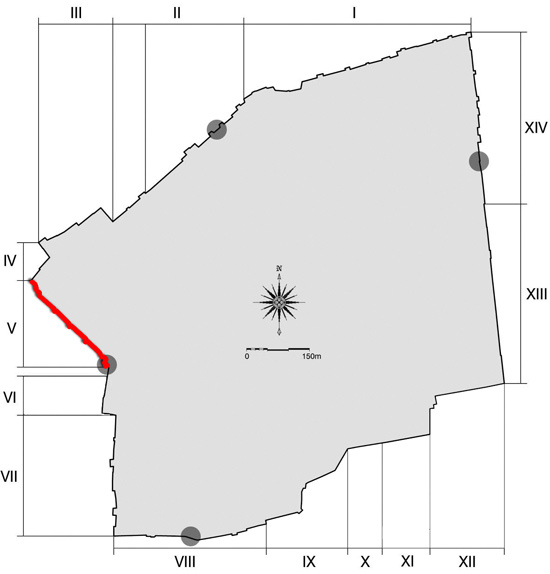
|
| Orientation map |
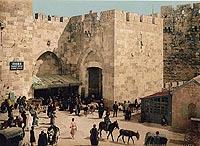
|
| 1. Jaffa Gate at the end of the nineteenth century. |
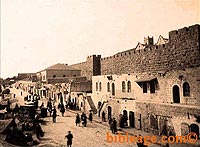
|
| 2. The wall's facade north of Jaffa Gate and the buildings adjacent to it at the end of the nineteenth century. |
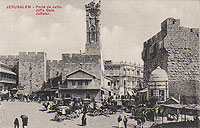
|
| 3. The facade of Jaffa Gate and the buildings that were built in it, circa 1900. |
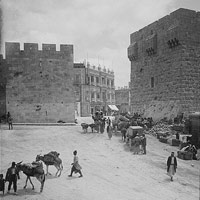
|
| 4. The facade of Jaffa Gate after the removal of the buildings. Matson collection. |
|















